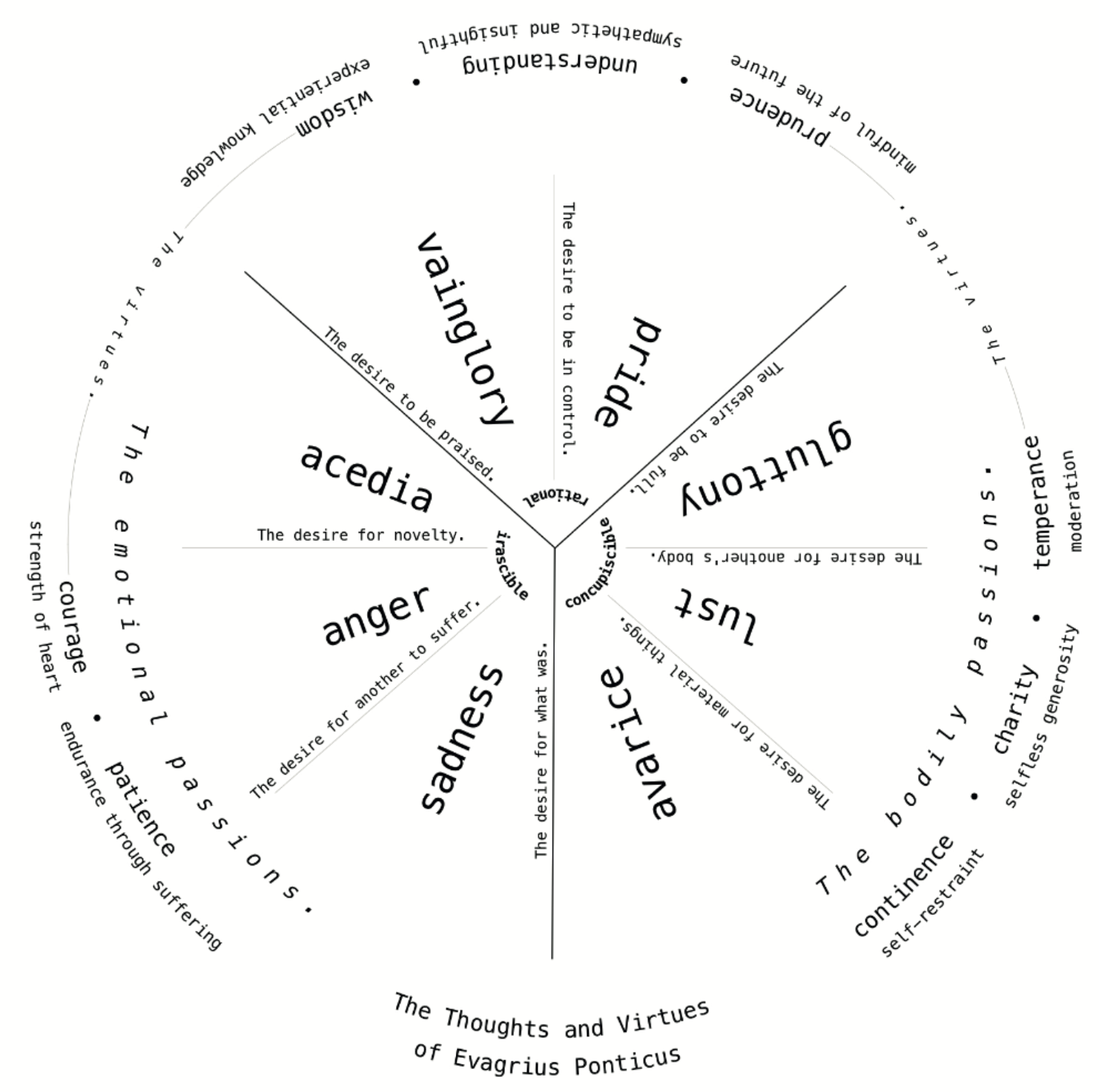
This is a map of Evagrius’ eight thoughts and the corresponding virtues. The research conducted on the eight thoughts detailed in the excerpt from my thesis below led to my development of this diagram. It serves as a quick reference to the meaning of each thought and virtue and places them within their corresponding Platonic categories.
 One of the most critical concepts to understand while studying and applying Evagrius’ work, is the nature of the deep connection between the eight thoughts and their corresponding virtues. In The Praktikos, Evagrius organizes the eight thoughts into the three parts of the soul as originally defined by Plato, i.e., the rational (pride, vainglory), the irascible (acedia, anger, sadness), and the concupiscible (avarice, impurity, gluttony).98 Each part of the soul has a corresponding set of virtues which are “birthed” as one struggles with the related troubling thoughts. For example, grappling with sadness produces courage and patience within the soul, and continence, charity, and temperance emerge when facing thoughts of gluttony. The key concept here is that the troubling thoughts and the virtues are two sides of the same coin. It takes courage to face sadness, but facing sadness is also a means to acquire courage.
One of the most critical concepts to understand while studying and applying Evagrius’ work, is the nature of the deep connection between the eight thoughts and their corresponding virtues. In The Praktikos, Evagrius organizes the eight thoughts into the three parts of the soul as originally defined by Plato, i.e., the rational (pride, vainglory), the irascible (acedia, anger, sadness), and the concupiscible (avarice, impurity, gluttony).98 Each part of the soul has a corresponding set of virtues which are “birthed” as one struggles with the related troubling thoughts. For example, grappling with sadness produces courage and patience within the soul, and continence, charity, and temperance emerge when facing thoughts of gluttony. The key concept here is that the troubling thoughts and the virtues are two sides of the same coin. It takes courage to face sadness, but facing sadness is also a means to acquire courage.
This dovetails nicely with the advice given by the author of The Cloud of Unknowing not to avoid or wish away the challenges we encounter in our lives, but rather to “look over their shoulders, as it were, searching for something else.”99 We would rather the often painful pull of inordinate desire not exist, yet since it is present nonetheless, we must “look right into it until we can look straight through it.”100 The struggle itself becomes a way we steady our gaze on God, who exists within and beyond the pain.
This concept echoes Wendy Farley’s theology of desire, understanding desire as both capable of wounding and of healing. Drawing on the map of Evagrius’ thoughts and virtues above, while pride (the desire to be in control) and vainglory (the desire to be praised) can wound deeply, enduring and reflecting upon these troubling thoughts builds prudence, understanding, and wisdom. Indeed, one cannot become wise without first facing pride.
Robert E. Sinkewicz, a translator of Evagrius’ writing, refers to Evagrius’ codification of the thoughts as an “advanced tactical manual designed to assist the monk in developing his faculty of discernment.”101 Evagrius’ work was a rich treasure trove of wisdom not only for the fourth and fifth-century monks of Nitria, Kellia, and Sectis, but also remains available to us today as a nuanced guide to navigating our relationship with God, self, and others, particularly during the more trying times in our lives.
98 Evagrius, Praktikos 89.
99 As quoted by M. S. Laird in A Sunlit Absence: Silence, Awareness, and Contemplation (New York: Oxford University Press, 2011), 126.
100 M. S. Laird, A Sunlit Absence, 126.
101 Evagrius and Robert E. Sinkewicz, Evagrius of Pontus, 137.

This post is part of the Desert Prayers Project, a component of my doctoral thesis work through Virginia Theological Seminary.